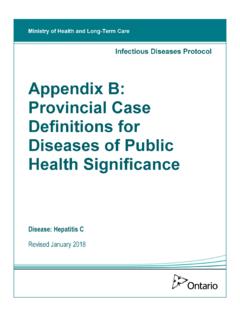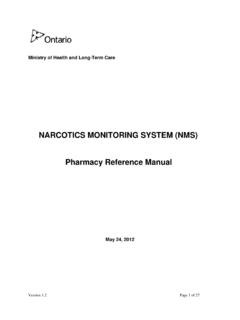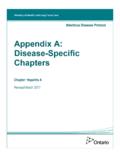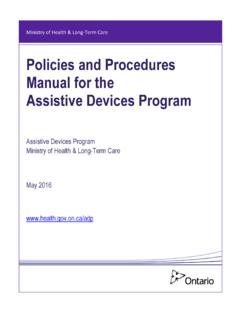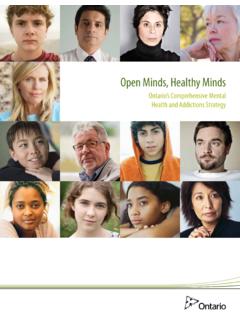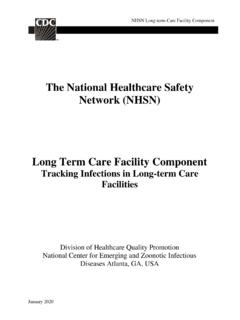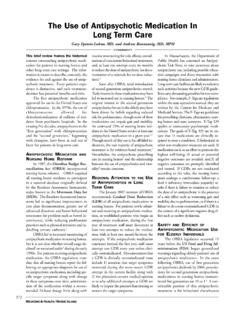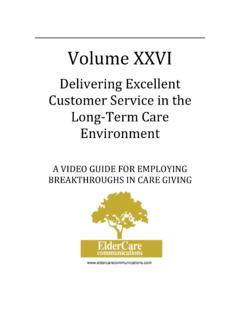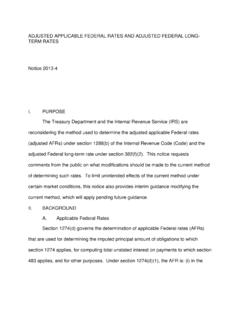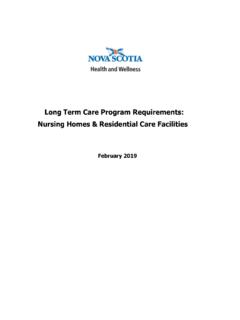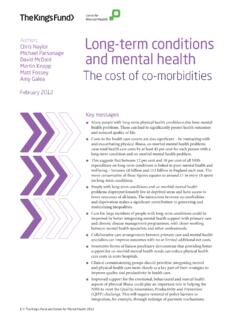Transcription of A Guide to the Long-Term Care Homes Act, 2007 and ...
1 A Guide to the Long-Term care Homes Act, 2007 and Regulation 79/10 Table of ContentsIntroduction ..1 Part I Fundamental Principle and Interpretation ..1-1 Policies and Records ..1-2 Part IIResidents Bill of Rights ..2-1 Mission Statement ..2-6 Safe and Secure Homes ..2-7 care Plans and Plans of care ..2-12 General Requirements for Programs ..2-20 Nursing and Personal Support Services ..2-22 Required Programs ..2-28 Responsive Behaviours ..2-33 Altercations and Other Interactions ..2-36 Behaviours and Altercations ..2-37 Restorative care ..2-38 Recreational and Social Activities ..2-41 Nutrition care , Dietary Services and Hydration Programs ..2-42 Medical Services ..2-52 Religious and Spiritual Practices ..2-54 Accommodation Services ..2-55 Pets ..2-59 Volunteers ..2-60 Prevention of Abuse and Neglect ..2-61 Reporting and Complaints (Complaints) ..2-67 Reporting and Complaints (Mandatory Reports) ..2-69 Reporting and Complaints (Critical Incidents).
2 2-80 Minimizing of Restraining ..2-84 Drugs ..2-101 Absences ..2-114 Discharge ..2-118 Part IVCouncils Residents Council ..4-1 Councils Family Council ..4-3 Councils General ..4-6A Guide to the Long-Term care Homes Act, 2007 and Regulation 79/10 1 IntroductionOntario s Long-Term care Homes Act, 2007 (LTCHA) and Ontario Regulation 79/10 (Regulation) made under the LTCHA came into force on July 1, 2010. The new LTCHA and the Regulation replace the Nursing Homes Act, Homes for the Aged and Rest Homes Act and the Charitable Institutions Act, and the regulations under those Long-Term care Homes in Ontario are now governed by one piece of legislation: the Long-Term care Homes Act, 2007. The LTCHA is designed to help ensure that residents of Long-Term care Homes receive safe, consistent, high-quality, resident-centred care . The goal is to create Long-Term care home environments where residents feel at home , are treated with respect, and have the supports and services they need for health and well-being.
3 The way to achieve this goal is through: An ongoing, province-wide commitment to the health and well-being of Ontarians living in Long-Term care Homes ; and Collaboration and mutual respect among residents, their families and friends, Long-Term care home licensees, service providers, caregivers, volunteers, the community and this GuideThis Guide provides a general overview of the LTCHA and the Regulation. The Guide does not address all aspects of the LTCHA and the Regulation and is made available for convenient reference only. It should be read in conjunction with the LTCHA and the Regulation and, in the case of any conflict, the provisions of the LTCHA and the Regulation are Guide is designed to align with the Table of Contents of the LTCHA and the Regulation. This Guide is divided into ten Parts, reflecting the ten Parts of the LTCHA and the Regulation as set out in the Table of Contents.
4 Users should consult their own legal counsel for all purposes of interpretation. Who May Use this Guide ?This Guide is intended to provide a plain language reference and to be a useful resource for the following: Long-Term care home licensees; Long-Term care home staff; Residents; Substitute Decision-Makers; Residents family members;A Guide to the Long-Term care Homes Act, 2007 and Regulation 79/10 2 Residents Councils; Family Councils; Volunteers; Local Health Integration Networks (LHINs); and Community care Access Centres (CCACs).TerminologyIn this Guide , a Long-Term care home will be referred to as a home for ease of reference. home will also be used to refer to the licensee . The licensee is the person who is licensed or approved to operate the home under the LTCHA and who is responsible for ensuring compliance with the requirements set out in the LTCHA and the the purposes of this Guide , unless otherwise specified, Director refers to the Director, Performance Improvement and Compliance Branch, Health System Accountability and Performance Division, Ministry of Health and Long-Term provide more context and help readers understand the LTCHA and the Regulation, this Guide includes the following additional information in some sections: Definitions include definitions found in the LTCHA and the Regulation.
5 In addition, there are other definitions taken from approved ministry policy sources. Key Linkages cross-reference other sections of the LTCHA and the Regulation that should be considered when reading that part of the Guide . Key Considerations provide additional information, resources or explanations. Notice The contents of this Guide are subject to change without notice from time to time and are for information purposes only. They are not intended to provide legal, financial or professional recommendations or advice. The Ministry of Health and Long-Term care (MOHLTC) cannot and does not represent or guarantee that the information in this Guide is current, accurate, complete or free of errors. Any reliance on any information in the Guide is solely at the risk of the user of the Guide . Users should always seek legal, financial or other professional advice relating to the information contained in this Guide .
6 Users should also consult their own legal counsel for all purposes of interpretation of the LTCHA and the MOHLTC assumes no responsibility for any changes, errors or omissions in any of the information contained in the Guide . The MOHLTC makes no representation or warranty of any kind whatsoever with respect to this Guide . In no event shall the MOHLTC, the A Guide to the Long-Term care Homes Act, 2007 and Regulation 79/10 3 Province of Ontario and their respective officers, employees, servants or agents be liable for any failure to keep the content of the Guide up-to-date, for errors or omissions contained in the Guide , or for any damages (including, without limitation, damages for loss of profits, business interruption or direct, indirect, incidental, special, consequential or punitive damages) arising out of or related to the use of this Guide (including all contents), whether under contract, in tort or under any other basis of Guide is the property of the MOHLTC and it shall not, in whole or in part, be reproduced without prior written permission from the MOHLTC.
7 Users may print the electronic version of the Guide for their own use. The LTCHA, the Regulation, and other Acts and Regulations referred to in this Guide are available at is a Long-Term care ACTION Line to register concerns or complaints about a home s compliance with the LTCHA and the Regulation. The Long-Term care ACTION Line is available at 1-866-434-0144 between the hours of 8:30 and 7:00 seven days a Guide to the Long-Term care Homes Act, 2007 and Regulation 79/101-1 Part I Fundamental Principle and InterpretationA. Overview Section 1 of the LTCHA sets out the fundamental principle to be applied in the interpretation of the LTCHA and the Regulation and section 2 of the LTCHA sets out the definitions for terms referred to in the LTCHA and the Regulation. B. LTCHA RequirementsSection 1 home : the Fundamental PrincipleThe fundamental principle to be applied in the interpretation of the LTCHA and the Regulation is that a home is primarily the home of its residents and is to be operated so that it is a place where its residents may live with dignity and in security, safety and comfort and have their physical, psychological, social, spiritual and cultural needs adequately met.
8 Section 2 IntepretationSection 2 of the LTCHA sets out the definitions for many of the terms referred to in the LTCHA and the Regulation. Some of these definitions are referred to in this Guide in the Definition boxes. For a complete list of definitions, see the LTCHA and the Regulatory RequirementsSections 1 to 7 of the Regulation set out the definitions for terms referred to in the Regulation. Some of these definitions also apply to terms used in the of these definitions are referred to in this Guide in the Definition boxes. For a complete list of definitions, see the LTCHA and the Guide to the Long-Term care Homes Act, 2007 and Regulation 79/101-2 Part I Policies and RecordsA. Overview Section 8 of the Regulation sets out the requirements relating to the home s policies and records. B. LTCHA RequirementsNone. C. Regulatory RequirementsSection 8 Policies, etc.
9 To be Followed, and Records. Where the LTCHA or the Regulation requires the home to have a plan, policy, protocol, procedure, strategy or system, the plan, policy, protocol, procedure, strategy or system must be: In compliance with and implemented in accordance with all applicable requirements under the LTCHA; and Complied with. Where the LTCHA or the Regulation requires the home to keep a record, the record must be kept in a readable and useable format that allows a complete copy of the record to be readily produced. A Guide to the Long-Term care Homes Act, 2007 and Regulation 79/102-1 Part II Residents Bill of RightsA. Overview Section 3 of the LTCHA sets out the Residents Bill of Rights, which addresses residents personal well-being and safety and includes the privileges, choices and protections available to all residents of a home . Some of the rights set out in this section are supported by further requirements in the LTCHA and the Regulation.
10 B. LTCHA RequirementsSection 3 Residents Bill of RightsThe Residents Bill of Rights may be enforced as though the resident and the home had entered into a contract in which the home agreed to fully respect and promote all of the resident s rights. The LTCHA, the Regulation, and any agreements between the home and the Crown or between the home and the resident must be interpreted in a way that advances the respect of the resident s ConsiderationThe Residents Bill of Rights expands on and strengthens the rights which existed in the legislation that governed Homes before the LTCHA. Dignity and Respect Every resident has the right to be treated with courtesy and respect and in a way that fully recognizes the resident s individuality and respects his or her dignity. Every resident has the right to exercise the rights of a citizen. Every resident has the right to be told who is responsible for and who is providing his or her direct care .
